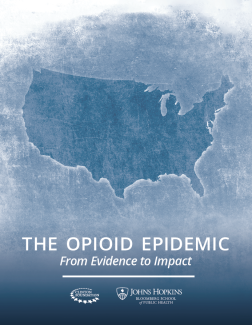The Opioid Epidemic: From Evidence to Impact

EXECUTIVE SUMMARY
While prescription opioids serve an invaluable role for the treatment of cancer pain and pain at the end of life, their overuse for acute and chronic non-cancer pain as well as the increasing availability of heroin and illicit fentanyl, have contributed to the highest rates of overdose and opioid addiction in U.S. history. Evidence-informed solutions are urgently needed to address these issues and to promote high-quality care for those with pain. This report is a response to that need. By providing an updated and expanded revision of a prior monograph, released in 2015, this report offers timely information and a path forward for all who are committed to addressing injuries and deaths associated with opioids in the United States. The Opioid Epidemic: From Evidence to Impact reflects a commitment to the three principles that motivated the original report:
- Informing Action with Evidence
- Intervening Comprehensively
- Promoting Appropriate and Safe Use of Prescription Opioids
Those principles led to the delineation of 10 topic areas across the spectrum of the problem ranging from how clinicians treat pain to treatment for opioid-use disorders to harm reduction strategies.
The findings of the report are comprised of evidence from these 10 topic areas, as well as 49 recommendations that are informed by that evidence.
The first half of the report, Improving the Safe Use of Prescription Opioids addresses five topics:
1. Optimizing Prescription Drug Monitoring Programs
2. Standardizing Clinical Guidelines
3. Engaging Pharmacy Benefits Managers and Pharmacies
4. Implementing Innovative Engineering Strategies
5. Engaging Patients and the General Public
The second half of the report includes five additional topics and is focused on addressing the challenges of Identifying and Treating People with Opioid-Use Disorders:
6. Improving Surveillance
7. Treating Opioid-Use Disorders
8. Improving Naloxone Access and Use
9. Expanding Harm Reduction Strategies
10. Combating Stigma
This report is intended as a resource for policymakers, clinicians who prescribe opioids and those who treat people with opioid-use disorders, people with opioid-use disorders and their families, researchers, journalists, law enforcement officials, health system administrators, employers, service providers and agencies at the local, state, and federal levels, community organizations, and members of the general public. It provides guidance for those who are searching for solutions to address the unacceptable toll of opioid-use disorders in the United States as well as ways to reduce prescription opioid overuse and to maximize the quality of care for those with pain.